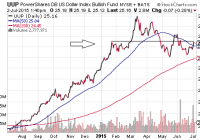ETFs To Play 3 Undervalued Sectors
Though a mountain of woes punctured the U.S. market momentum in the first half of 2015 with the S&P 500 barely adding gains thanks to global growth worries, rising rate concerns and specifically the strength of the dollar, the second half looks to be shaping up in a great way. Greece worries have tailed off as the nation somehow managed to strike a debt deal with its international lenders, in turn soothing the nerves of global investors. Back home, the all-important Q2 earnings season got off to a strong start with Finance sector – the backbone of any economy – living up to expectations. All these once again fueled up the market with the Nasdaq registering consecutive record highs in mid-July and the S&P 500 trading at just 0.3% discount to its all-time high hit in May due to the massive rally we’ve seen since for the last six years. So, one might wonder if any value sector is left at all. A value play is especially required given the disappointing earnings string from a few tech bellwethers that has made investors jittery. No doubt, with all the major indices trading at around all-time highs, it is hard to find value plays at home. But for those investors fervently looking for undervalued sectors, there are still a few hidden treasures out there. While several indicators are used to examine any stock or sector’s valuation status, price-to-earnings ratio or P/E has been the most widespread. We have identified three sector picks having the lowest forward P/E ratio for this year’s earnings in the pack of 16 S&P sectors classified by Zacks and detail the related ETFs to play those sectors’ undervalued status. Auto – First Trust Nasdaq Global Auto ETF (NASDAQ: CARZ ) The U.S. automotive industry is accelerating with rising income, persistently lower energy prices, a low interest rate environment, and growing consumer confidence. All these drove auto sales 4.4% higher to 8.52 million units in the first half of 2015, signifying the best six months in a decade. And if this was not enough, auto sales are likely to hit 17 million in full-year 2015, a level never touched in the last 15 years. Despite strong fundamentals, the sector has a P/E ratio of 10.8 times for 2015 and 9.3 times for 2016, the lowest in the S&P universe, as per the Zacks Earnings Trend issued on July 16. Investors should note that the P/E of auto industry trades at 41.3% discount to the current year P/E of S&P and 43.6% discount to the next year P/E. The space is down 4.5% so far this year which says that it is time to turn its loss into your gains. Investors should note that there is only a pure play CARZ in the space that provides global exposure to nearly 40 auto stocks by tracking the Nasdaq OMX Global Auto Index. CARZ has a Zacks ETF Rank #2 (Buy) and is up 1.2% so far this year (as of July 20, 2015). Finance – Vanguard Financials ETF (NYSEARCA: VFH ) The financial sector has set an upbeat tone this earnings season. Several factors including fewer litigation charges, effective cost control measures, loan growth and investment banking activities have given Q2 earnings a boost and made up for still-the low interest rate environment which has long been bothering the sector’s revenue backdrop. Investors should also note that the Fed is preparing for an interest rate lift-off which will pave the way for financial stocks and the related ETFs going forward. The space has a current-year P/E of 14.3 times, a 22.3% discount to the S&P while its next year P/E stands at 13.1 times, a 20.6% discount to the S&P 500’s 2016 P/E. The space has added 2.2% so far this year (as of July 20, 2015). While there are plenty of financial ETFs, investors can take a look at Zacks #1 (Strong Buy) ETF VFH. This $3.48-billion ETF holds a broad basket of over 550 stocks in its portfolio. The fund is up 3.7% so far this year. Transportation – iShares Dow Jones Transportation Average Fund (NYSEARCA: IYT ) This one could be a risky bet as the sector is out of favor right now, having retreated big time from the year-to-date frame (down over 12%). A strong dollar is taking a toll on the profits of big transporters, but other drivers including stepped-up economic activities and cheap fuel are still alive and kicking. This raises optimism on the transportation sector going forward. Actually, transportation stocks gave a havoc performance last year having advanced over 25%. Thus, probably overvaluation was the concern which pushed the space in the bear territory. The current and the next year P/Es for the sector are 13.2 and 12.6 times, a 28.3% and 23.6% discount to the S&P 500, respectively. One way to play this trend is with iShares Dow Jones Transportation Average Fund, which tracks the Dow Jones Transportation Average Index and holds 20 stocks in its basket. The fund has a Zacks ETF Rank #3 (Hold) with a High risk outlook. Original Post
